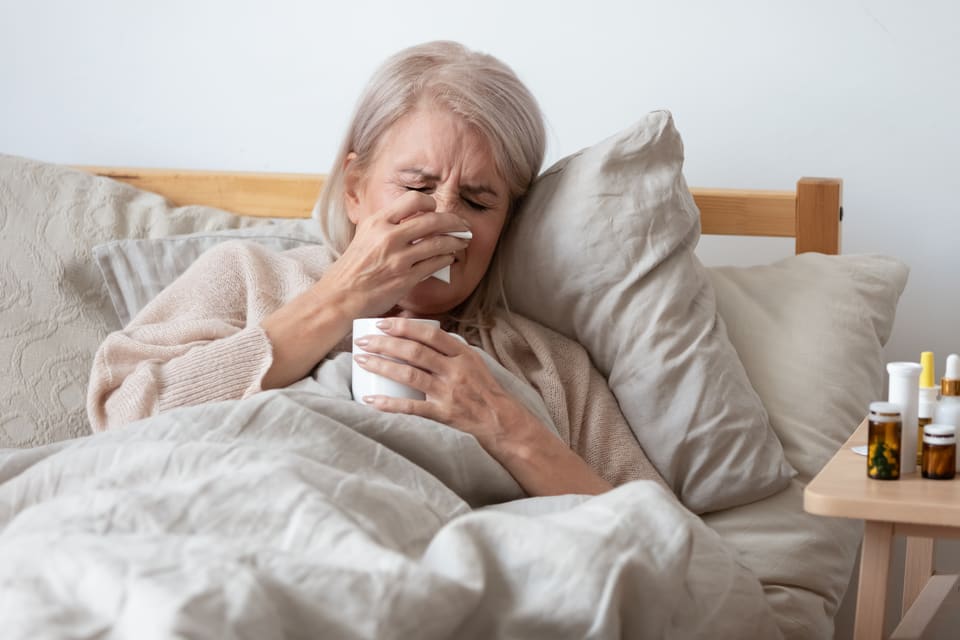
A Guide to Common Infections in the Elderly: Signs, Prevention, and Treatments

Seniors are more prone to infections because their immune system becomes less efficient as they age. Common infections like pneumonia, influenza, skin infections, and urinary tract infections are often mild. But for seniors, these illnesses may be much harder to diagnose, leading to chronically poor health, ongoing discomfort, and a higher risk of hospitalization. To prevent and treat these common infections, it’s important to stay up to date on vaccines and practice good hygiene. It’s also crucial to look out for common signs and symptoms of infection in the elderly including chills, fever, aches, loss of appetite, and confusion.
Let our care assessment guide you
Our free tool provides options, advice, and next steps based on your unique situation.
Key Takeaways
- Seniors are more prone to infections. Aging reduces the effectiveness of the immune system, making it easier to get infected.
- Certain infections are especially common in older adults. These include bacterial pneumonia, influenza, skin infections, and UTIs.
- Be on the lookout for general signs of infections. These may include fever, chills, aches, confusion, and loss of appetite.
- Common infections can be prevented and treated. Good hygiene and getting vaccinated can help prevent some infections, while prescribed medications can help treat them.
Why the elderly are more prone to infections
Physiological changes in aging affect the immune system causing seniors to be more vulnerable to certain infections than younger patients. One of those changes includes the reduced production of lymphocytes — particularly B cells and T cells.[01] B cells produce antibodies that attack bacteria, viruses, and toxins that enter the body while T cells destroy any infected cells within the body.[02]
Even blood samples can miss some signs of infection, since senior patients might not show a spike in their white blood cell count — a common indicator of infection — even if they’re sick.[03]
Health complications can weaken the immune system
Many seniors tend to have multiple chronic conditions that can make them more susceptible to infections. For instance, seniors with chronic obstructive pulmonary disease (COPD) are sometimes more prone to respiratory infections and pneumonia due to associated symptoms and medications.[04]
Another common condition that causes an increased risk of infections is diabetes. High blood sugar causes immune dysfunction, which often causes more infections in diabetic seniors.[05]
Four common infections in the elderly
Infections have become easier to treat with modern medicine, but pneumonia and influenza continue to be among the top causes of death in adults 65 and older.[06,07] To help your loved one ward off infections, you can stay vigilant by learning more about the most common infections. Below, we cover symptoms, prevention methods, and treatment options to help you prevent serious illness and promote greater wellness and longevity for your loved one.
1. Bacterial pneumonia
More than 60% of seniors over 65 get admitted to hospitals due to pneumonia.[08]Pneumonia is perhaps the most lethal infection in older adults in the U.S., and it poses a greater risk to senior patients than to younger populations for a variety of reasons. Reduced lung capacity, increased exposure in community settings, and a weakened immune system caused by underlying conditions all combine to make pneumonia even more serious as many seniors age.
Symptoms of bacterial pneumonia
Common symptoms like the following are less frequent in elderly pneumonia:[09]
- Cough
- Fever
- Chills
Non-respiratory symptoms are often more common in seniors with pneumonia:[09]
- Confusion
- Delirium
- Disorientation
- Decreased appetite
How to prevent and treat pneumonia in seniors
As a precaution, doctors recommend a pneumococcal vaccine, as it can effectively prevent some types of pneumonia.[10] Before moving forward with vaccination, be sure to check with a doctor to see what’s right for you or a loved one. For infected seniors doctors usually prescribe an antibiotic treatment to treat bacterial pneumonia.
2. Elderly influenza
Influenza and pneumonia are leading causes of death around the world.[11] Because seniors often have weakened immune systems and multiple chronic conditions, they’re at an increased risk of developing severe complications from influenza, such as pneumonia. And since influenza is most commonly spread by coughing and sneezing, the risk of infection increases in closed environments, like nursing homes.
Symptoms of influenza
Common symptoms of influenza include the following:[12]
- Fever
- Chills
- Dry cough
- General aches and pains
- Headache
- Fatigue
Keep in mind, influenza may present different symptoms in older adults. For instance, some less common symptoms of the flu include sore throat, sneezing, a stuffy nose, or stomach problems.
How to prevent and treat the flu in seniors
To help prevent the flu in a senior loved one, the following tips are recommended:[13]
- Get an annual flu vaccine designed for seniors
- Wash your hands
- Avoid close contact with people who are sick
- Clean and disinfect frequently touched surfaces where possible
Some seniors may have adverse reactions to flu vaccines, so always ask a doctor before scheduling a flu vaccine appointment. For already-infected seniors, physicians may prescribe antiviral medications to reduce symptoms. Every year, the FDA approves antiviral drugs to treat the flu in patients at high risk for serious flu complications.

Let our care assessment guide you
Our free tool provides options, advice, and next steps based on your unique situation.
3. Elderly skin infections
Seniors are much more prone to developing skin infections because of their skin’s declining ability to heal itself and resist disease. They may also be more prone to skin infections due to existing conditions or diseases that make their skin vulnerable.[13]
Common skin infections in elderly patients include:
- Bacterial or fungal foot infections, which can be more common in those with diabetes
- Cellulitis
- Drug-resistant infections, like Methicillin-resistant Staphylococcus aureus (also known as MRSA)
- Viral infections like herpes zoster (shingles)
Symptoms of skin infections in the elderly
If you or a loved one are experiencing the following symptoms, it may be a sign of a skin infection:[13]
- Pressure sores (or bedsores)
- Wounds and ulcers
- Unusual itching
- Painful areas of skin
How to prevent and treat skin infections in the elderly
To prevent skin infections, the following practices are recommended for seniors:[14,15]
- Practice good hygiene
- Avoid smoking
- Treat cuts and wounds properly
Bacterial infections, like MRSA, are more commonly contracted by older adults in hospitals. So hygiene practices, like frequent handwashing and disinfection, are especially important if your loved one lives in a senior living community or an institutional care setting.
Most skin infections are treatable, and shingles is highly preventable with a simple vaccine. The CDC recommends adults 50 and older get two doses of the shingles vaccine, which is called Shingrix.[16]
4. Urinary tract infections
Urinary tract infections (UTIs) are the most common cause of bacteremia — a type of bloodstream infection — in older adults.[17]. Diabetes and catheter use can increase the risk of UTIs in elderly people.
Symptoms of UTI in seniors
UTI symptoms are unique in older adults — they don’t always experience pain or frequent urination, which are common in younger patients.
Some common symptoms of a UTI in seniors may include:[17]
- Low blood pressure
- Tachycardia (or rapid heart rate)
- Urinary incontinence
- Poor appetite
- Drowsiness
- Frequent falls
- Delirium
How to prevent and treat UTIs in seniors
To actively prevent urinary tract infections, it’s important to keep a healthy bladder by following these tips:[18]
- Drink enough water (typically 64 ounces per day).
- Urinate shortly after you need to and empty your bladder completely.
- Urinate after sex.
- Wipe front to back.
- Wear loose, cotton underwear.
If you’re worried your loved one might have a UTI, talk to their doctor. They can send a urine sample for a urinalysis lab test to confirm a diagnosis. From there, they may prescribe antibiotics to treat the UTI, if needed.

Talk with a Senior Living Advisor
Our advisors help 300,000 families each year find the right senior care for their loved ones.
How senior living communities can help prevent infections
If a senior loved one is having recurrent infections, it may be time to seek outside help. Senior living communities employ caregivers who can help seniors practice good hygiene. Furthermore, many states require assisted living and memory care communities to have an infection protocol and provide a clean environment to prevent the spread of such common infections in the elderly.
To learn more about how senior living communities work to prevent the spread of infection, and for guidance on senior living in general, contact one of A Place for Mom’s local senior living experts. Their expertise is provided at no cost to you. Together, they’ve helped hundreds of thousands of families find a best-fit senior living solution for their loved ones.
Encarnacion, M., Beata, B., & Dorshkind, K. (2013, March). Causes, consequences, and reversal of immune system aging. The Journal of Clinical Investigation.
National Human Genome Research Institute. National Institutes of Health. (2024, February 21). Lymphocyte.
Compté, N., Dumont, L., Bron, D., De Breuker, S., Praet, J., Bautmans, I., & Pepersack, T. (2018, December). White blood cell counts in a geriatric hospitalized population: A poor diagnostic marker of infection. Experimental Gerontology.
Sethi, S. (2010, June). Infection as a comorbidity of COPD. European Respiratory Journal.
Casqueiro, J., Casqueiro, J., & Alves, C. (2012, March). Infections in patients with diabetes mellitus: A review of pathogenesis. Indian Journal of Endocrinology and Metabolism.
Centers for Disease Control and Prevention. (2001, March). Trends in causes of death among the elderly.
National Center for Health Statistics. Centers for Disease Control and Prevention. (2021, November). Sepsis-related mortality among adults aged 65 and over: United States, 2019.
Henig, O. & Kaye, K. S. (2017, December). Bacterial pneumonia in older adults. Infectious Disease Clinics of North America.
Mouton, C. P., Bazaldua, O. V., Pierce, B., & Espino, D. V. (2001, January 15). Common infections in older adults. American Family Physician.
Centers for Disease Control and Prevention. (2023, September 21). Pneumoccal.
Noymer, A. & Nguyen, A., M. (2014, January). Influenza as a proportion of pneumonia mortality: United States, 1959-2009. Biodemography and Social Biology.
National Institute on Aging. National Institutes of Health. (2022, June 14). Flu and older adults.
Falcone, M. & Tiseo, G. (2023, April). Skin and soft tissue infections in the elderly. Current Opinion in Infectious Diseases.
Wisconsin Department of Health Services. (2024, January 19). Skin infections: Prevention and disinfection.
American Osteopathic College of Dermatology. Smoking and its effect on skin.
Centers for Disease Control and Prevention. (2023, May 8). What everyone should know about the shingles vaccine (Shringix).
Laborde, C., Bador, J. Hacquin, A., Barben, J., Putot, S., Manckoundia, P., & Putot, A. (2021, March). Atypical presentation of bacteremic urinary tract infection in older patients: Frequency and prognostic impact. Diagnostics.
National Institute on Aging. National Institutes of Health. (2022, January 24). 15 tips to keep your bladder healthy.
Senior living options in all states
The information contained on this page is for informational purposes only and is not intended to constitute medical, legal or financial advice or create a professional relationship between A Place for Mom and the reader. Always seek the advice of your health care provider, attorney or financial advisor with respect to any particular matter, and do not act or refrain from acting on the basis of anything you have read on this site. Links to third-party websites are only for the convenience of the reader; A Place for Mom does not endorse the contents of the third-party sites.
Make the best senior care decision
Make the best senior care decision